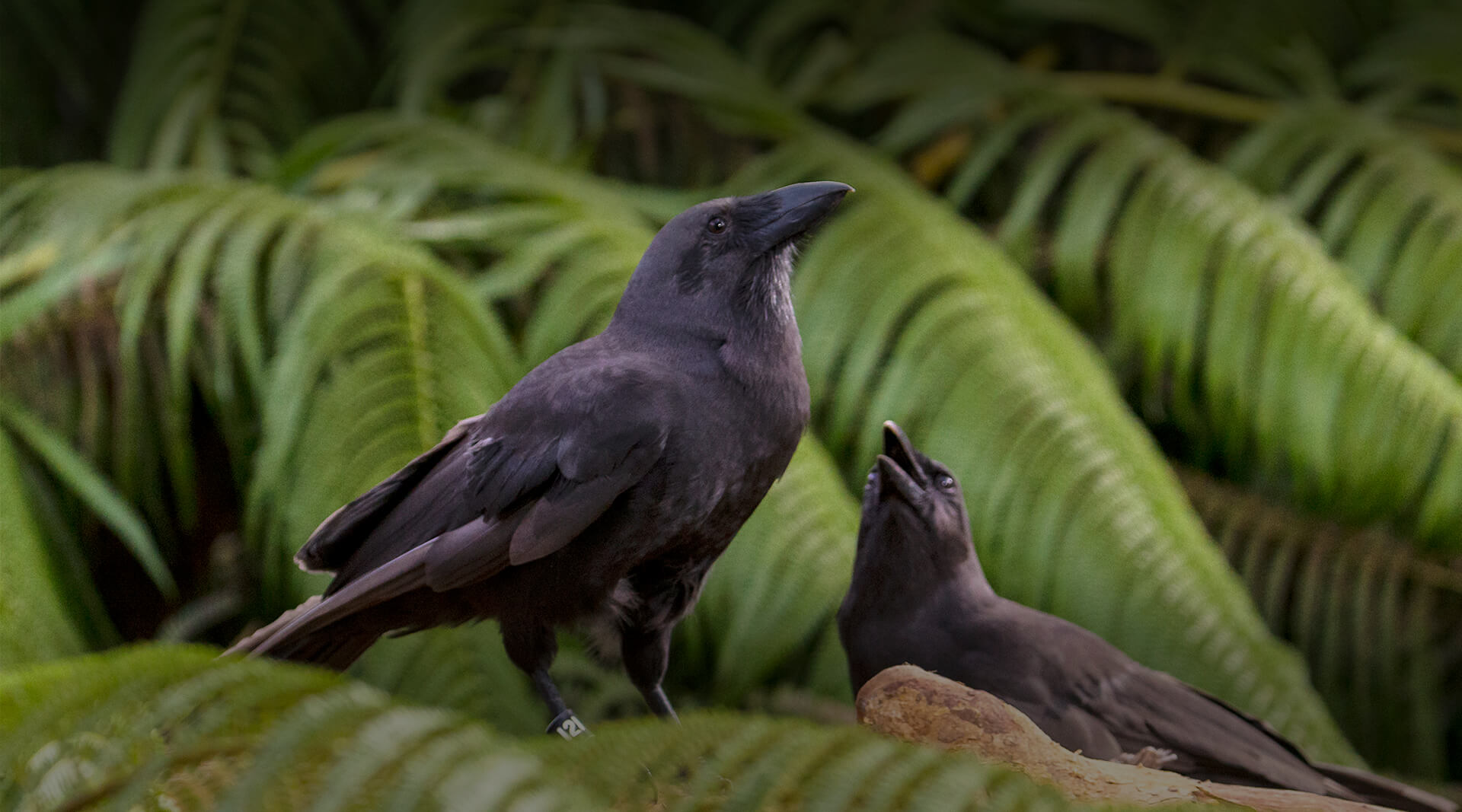ʻAlalā (Hawaiian Crow): Perched on the Brink
IUCN Conservation Status: Extinct in the Wild
‘Alalā once flew freely through the South Kohala, Kona, Kaʻū, and Puna districts of the Hawaiian Islands, dispersing seeds and helping tropical plants to flourish. Beloved for their intelligence and brazen charisma, these birds filled the forests with their raucous calls.
Cats, dogs, rats, and mongooses have since been introduced to the Hawaiian Islands, and like many native birds, the ʻAlalā have not evolved the necessary adaptations for avoiding these invasive species. Some of these species—such as cats, and non-native insect vectors like mosquitos—have introduced avian diseases. These threats were intensified by the fragmentation and destruction of the birds’ forest habitat. As the ʻAlalā numbers plummeted, their populations began to suffer from inbreeding depression, and the situation grew dire.
While the ʻAlalā are facing an uncertain future, their story is also one of hope: San Diego Zoo Wildlife Alliance and our conservation partners are working tirelessly to innovate new solutions that will bring this species back from the edge of extinction and reintroduce them to their forest homes.
Collaborative Conservation
Securing a future for these island icons requires innovation and teamwork. Our Hawaiʻi Endangered Bird Conservation Program focuses on the propagation of endangered Hawaiian forest birds, including the ʻAlalā, at two centers in Hawaiʻi—the Keauhou Bird Conservation Center on Hawaiʻi Island, and the Maui Bird Conservation Center, on the slopes of Haleakalā. Our work is part of a long-standing partnership with the U.S. Fish and Wildlife Service and the Hawaiʻi Department of Land and Natural Resources–Division of Forestry and Wildlife, as well as many other partners. The two centers include aviaries, a veterinary clinic, and dedicated wildlife care experts.
In the Field
Our ʻalalā propagation program has resulted in an increase in the population from fewer than 20 birds in the late 1990s to more than 110 birds today. “Herculean efforts by diverse and dedicated teams over the years have brought about a dramatic turnaround for the ʻAlalā,” says Ronald Swaisgood, Ph.D., Brown endowed director of recovery ecology at the San Diego Zoo Wildlife Alliance. “We dare to hope just a little more each day.”
Our intensive approach starts with monitoring ʻalalā breeding activity using remote cameras. In preparation for releasing birds that will one day reproduce in the wild, we are focused on developing techniques to encourage parent birds to breed completely on their own. Such behaviors are essential for the survival and establishment of ʻAlalā released into the wild.
Our challenge continues to be providing the ʻalalā with the skills that they need to thrive and breed successfully after reintroduction. During our last series of reintroductions, our conservation team released and monitored ʻAlalā in native forests on the slopes of Mauna Loa. We have learned that releasing juvenile birds in a social group and providing them with supplemental food results in high survival rates for the first year after release. We also work on enhancing predator-avoidance behaviors, to encourage the birds to respond faster to their natural predator, the ʻio, or Hawaiian hawk, which is also endangered. Recovering these iconic Hawaiian species will continue to require innovation and collaboration, so that they will thrive in their native forests.
Saving species also requires inspiring and empowering the next generation of conservationists. Our ‘Alalā Reintroduction Community Inquiry Program engages Hawaiʻi Island science teachers with scientifically relevant and culturally significant curricular activities and empowers Hawaiʻi Island students to ask original questions and construct experiments for answering them, in the context of Hawaiian culture and biodiversity. The program enhances students’ inquiry and critical thinking skills, their interest in STEM careers related to species recovery, and their appreciation of their unique natural heritage and how human activities impact local ecosystems. By engaging in scientific investigations focused on the ‘Alalā, students will discover for themselves its ecological significance and be inclined to advocate on its behalf.
San Diego Zoo Wildlife Alliance scientists process and analyze biological samples from ʻalalā in our care. By understanding the challenges faced by ʻAlalā, we hope to prevent and treat diseases and other health issues.

